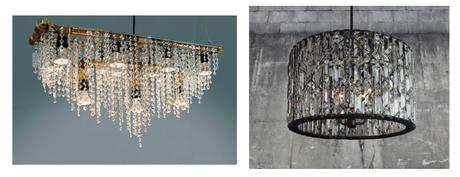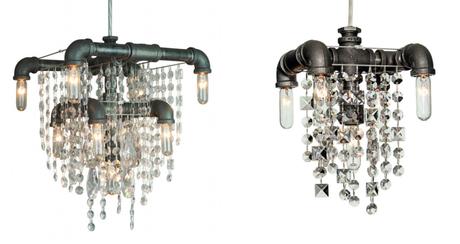Hello, everyone! Recently, I had an opportunity to interview Michael McHale, who is revolutionizing the way people think about their lighting. Michael is currently working on his Matrix collection, doing all of the lighting for a new restaurant in Istanbul, and is close to finishing a hotel project in London's Convent garden. He also recently finished a beautiful piece for noted LA interior designer Erinn Valencich. In spite of his busy schedule, he answered all my questions and I'm thrilled to share them with you today. I've added some of his work here for you to enjoy!

How did you get started with the lighting industry?
By complete accident and relatively late in life. For most of my career I was an entertainment lawyer in the television industry. I was attracted to creative industries but my own creative instincts had been shut down decades before.
The lighting idea happened after I had left the legal world due to chronic lack of enthusiasm. I had kind of a wilderness period, trying out different things, and in the middle of it, I decided to buy a fixture for my apartment, went to Design Within Reach, and hated what they had.
What inspires your design style?
I am inspired by restaging everyday things - workhorse items in the built environment that we have all trained our eyes to ignore. We use their own disciplined geometry to create new but simple and familiar lighting forms.
Do you start with a material that you want to use and design around or the other way around?
Originally, it was the design that mattered. But as we started working with industrial fittings, we discovered that then using them for our purposes, that they created a unique new design language, which became the basis of the look of most of what we do. So at this point I can't distinguish between the two ideas. For me, the materials we use have already been designed. We are harnessing that language.

Well, in the first instance, lead. Historically lead oxide and potash get mixed in with molten silica - sand - in order to allow light to refract as it passes through. The percentage of lead determines what the glass is called. If the lead content is 15%, that is generally referred to as leaded glass. Above, I believe, 20% it is called crystal, with the maximum possible lead content (and highest crystal quality) being around 30%, which is what we use.
But that is not the only indicator of quality. Process is a very important part of crystal production, and in particular how the crystal is allowed to cool. Most crystal cools like bread out of the oven - the outer surface cools first and the core, last. This creates very tiny striations between the temperature bands, which you can see in the finished product. Really good crystal makers will control that cooling process so everything cools at the same rate. This creates a condition called "optical purity." meaning that the rays of light going through the crystal are not moved by imperfections in the crystal. We will work only with optically pure crystal.
Any tips on cleaning chandeliers?
Our customers recommend a product that allows you to put down papers below the chandelier just to spray the thing. No wiping required. I've never tried it myself.
What's the new hot design trend in chandeliers?
Well, I am more a of maker than a consumer of chandeliers, and I also make what I think is beautiful, rather than what the market demands so I may not have my finger on that particular pulse. There are not many new ideas in lighting. LED technology has made great strides in the last few years and there have been a lot of really cool new light fixtures which harness that technology. To my eye, though, a lot of them appear to me to be lit sculptures more than light fixtures. The form is the main thing about them, and the function is an afterthought. That's not to say they aren't great to look at. It's just not my thing. I'm more about function.
Our new Matrix Collection, though, really IS a new idea in lighting. An idea so good and so obvious, that most people are amazed that it hasn't already been a thing. We've been developing the idea for the last several years and we think we have got the execution just right. So in a year's time, I'm hoping the most exciting new thing in lighting will be that collection, and that I won't be the only person who thinks so.

Can you tell us how lighting adds to the room decor? Are there any design tips you would like to share with my readers?
Yes. Lighting is the jewelry of your home. It is the first thing that people look at. Don't waste the opportunity to make an impression by playing it safe with something everyone has seen before. Most lights sold today are derivations of designs that came out in the mid-fifties. Over 60 years ago! Most people design the room first then find a light which will complement it. My advice is to do the opposite. Buy the light first. By it's position in the room, it will always be the first thing people see. Then buy everything else to work with it.

